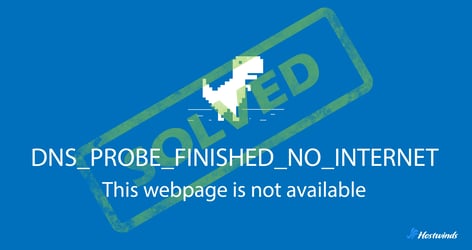Hostwinds Blog
Search results for:

DNS_PROBE_FINISHED_NO_INTERNET: What It Means and How to Fix It
by: Hostwinds Team / June 24, 2025
Running into the DNS_PROBE_FINISHED_NO_INTERNET error can be a bit of a headache, especially when you're just trying to load a website. This message usually means your browser or device isn't able to connect to the internet—often because something's going wrong with DNS.
In this guide, we'll explain what this error actually means, when it shows up in just your browser vs. your whole device, and what you can do to fix it.
What Is DNS_PROBE_FINISHED_NO_INTERNET?
When you visit a site, your browser needs to translate the domain name (like example.com) into an IP address. That's what DNS (Domain Name System) is for. If you're not familiar with this process, here's a detailed guide on how the Domain Name System works.
If that process fails and your device can't connect to the internet, Chrome will show this message:
DNS_PROBE_FINISHED_NO_INTERNETThis can happen for a bunch of reasons—from a simple Wi-Fi hiccup to a misconfigured DNS setting. The trick is figuring out where the problem is happening: in your browser, or on your device in general.
If the Error Only Happens in Your Browser
Sometimes, the issue is limited to Chrome (or another browser), while everything else on your device still connects just fine. If that's the case, the problem is probably related to your browser's settings or cache.
In some situations you may be running into another browser-related DNS error like ERR_NAME_NOT_RESOLVED, or a generic 'Webpage Not Available' in Chrome.
Possible Causes:
- Chrome's internal DNS cache is outdated
- A browser extension is interfering
- Proxy settings were changed
- You're using an old version of Chrome
- Something in Chrome's settings got tweaked unintentionally
What to Try:
1. Clear Chrome's DNS Cache
Chrome keeps a separate DNS cache, which can get out of sync.
1.Open Chrome
2. Type this into the address bar and hit Enter:
chrome://net-internals/#dns3. Click Clear host cache
4. Close and reopen the browser
2. Turn Off Extensions
Extensions can sometimes block connections or mess with DNS requests.
1.Go to:
chrome://extensions/2. Disable all extensions
3. Refresh the page you were trying to visit
4. If that fixes it, re-enable extensions one at a time to find the troublemaker
3. Reset Chrome Settings
This rolls back any network settings that may have changed.
- In Chrome, open Settings
- Scroll down and click Reset settings
- Select Restore settings to their original defaults
This won't delete your bookmarks or history.
If It Happens Across Your Whole Device
If nothing connects—websites, apps, email—then the issue is more likely with your device or network. That could mean your connection is down, or your DNS settings aren't working the way they should.
For more troubleshooting tips, check out these additional steps for DNS server not responding errors.
Common Causes:
- No internet connection
- DNS server is down or not responding
- Router or modem needs a reboot
- Network drivers are outdated or glitching
- A VPN or firewall is blocking access
- Your device needs a fresh IP address
Steps to Fix It:
1. Restart Your Router and Modem
This one's easy—and often works. Unplug both for 30 seconds, then plug them back in.
2. Flush DNS and Renew IP Settings (Windows)
1.Open Command Prompt as Administrator
2. Type the following commands, pressing Enter after each:
ipconfig /flushdns
ipconfig /release
ipconfig /renew
netsh int ip reset
netsh winsock reset3. Restart your computer
3. Switch to a Public DNS Server
If your ISP's DNS servers are acting up, switching to Google or Cloudflare's DNS can help.
Google DNS:
- 8.8.8.8
- 8.8.4.4
Cloudflare DNS:
- 1.1.1.1
- 1.0.0.1
On Windows:
- Open Control Panel > Network and Internet > Network and Sharing Center
- Click Change adapter settings
- Right-click your active network > Properties
- Double-click Internet Protocol Version 4 (TCP/IPv4)
- Choose Use the following DNS server addresses and enter the ones above
On macOS:
- Open System Settings > Network
- Choose your active connection and go to Details
- Click the DNS tab and add the new addresses
4. Update Network Drivers (Windows)
- Open Device Manager
- Expand Network adapters
- Right-click your adapter > Update driver
- Choose Search automatically for drivers
5. Disable VPN, Antivirus, or Proxy
Try temporarily turning off any VPN or security software. These can sometimes block DNS requests or reroute your connection.
If You've Tried Everything and It's Still Not Working
Here are a few last things to check:
- Test another device: If it's also offline, your network is likely the issue.
- Use a mobile hotspot or different network: If your device works there, your original network might need a closer look.
- Call your internet provider: There might be an outage or a DNS problem on their end.
If you still find yourself running into problems, it might be worth checking for NXDOMAIN-related DNS issues.
Quick Fix Cheat Sheet
Where the Problem Is | What to Try |
Just the browser | Clear Chrome's DNS cache, turn off extensions, reset browser settings |
Whole device | Reboot router, flush DNS, update drivers, change DNS servers |
Still stuck | Test another device/network or reach out to your ISP |
Wrapping Up
The DNS_PROBE_FINISHED_NO_INTERNET error can definitely throw a wrench in your day, but it's usually something you can fix with a few quick checks. Whether it's Chrome acting up or a deeper issue with your internet connection, narrowing it down helps you solve the problem faster.
Looking for more easy-to-follow guides? Check out our tutorials for tips on fixing common network issues, working with servers, and more.
Written by Hostwinds Team / June 24, 2025
